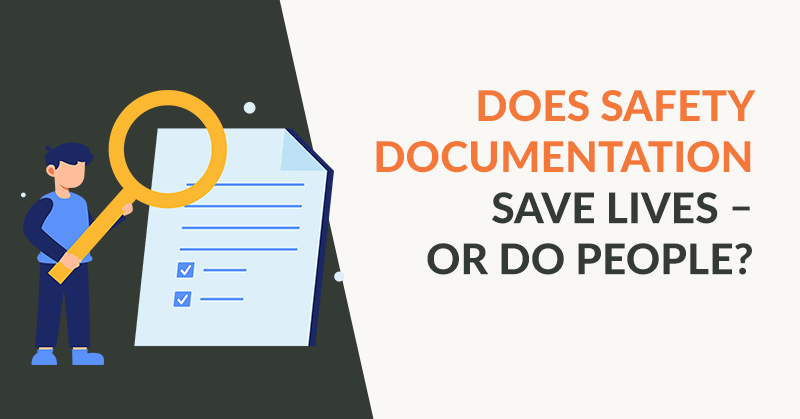Beyond ticking your risk management box, is safety documentation all that necessary for keeping people safe?
At last year’s Safeguard National Health and Safety Conference in Auckland, Andrew Barrett facilitated this debate between leading NZ health and safety experts.
Leading health and safety lawyer, Grant Nicholson, and University of Auckland’s Health, Safety and Wellbeing Manager, Robert Powell, argued for the proposition. GM Health and Safety Innovation at Construction Health, Jon Harper Slade, and H&S Consultant (at the time with Rocket Lab), Moni Hogg, were in opposition.
Get fresh H&S insights weekly
Leading NZ health and safety experts debate the importance of safety documentation at the Safeguard Conference last year
Here are our key takeaways from the debate:
Documentation provides structure – but only if it’s fit-for-purpose
Safety documentation can give workers clear guidelines on how to deal with emergencies and how to work safely, but that’s only possible if the procedures are created with a true and accurate understanding of how the business operates.
In Robert’s experience, it can mean the difference between someone making it home to loved ones alive – or not.
“We had a marine biology class go down to the Wairarapa, quite a far distance away from the nearest hospital. The activity itself went well, and then they were having a swim at the end of the day – someone stood on a stingray.
“They had an emergency plan that said if something happens, hit the emergency locator beacon. So, they hit it. Next thing you know, a helicopter has turned up. You didn’t hear about it in the papers because the plan worked. They catered for logical emergencies that were likely to happen, the plan worked, it didn’t snowball into a disaster, and that’s a prime example of paperwork saving lives at the university.”
Base documentation on real work
If we’re not careful, safety documentation can also make the workplace less safe, says Jon.
“No business ever got better or safer with its people locked in offices doing paperwork when they could be out looking at how the operation works.”
Rocket Lab has integrated health and safety management within their teams, placing responsibility in the hands of those who do the work daily. They’ve also integrated it with their work systems, creating a user-driven structure that is easily accessible by the teams who need it to manage their safety.
“We’ve got a very good safety record, and it’s been a key success factor in getting to where we are in terms of being extraordinarily competitive.
“There’s lots of evidence that shows that safety documentation crowds out other health and safety activities – people who do the work only have so much time to spend in a day on safety. That’s why we handed safety documentation over to the teams to decide what they needed.”
Stop being reactive – aim for smarter safety
Jon only has to think about the paperwork that he’s done within organisations in the name of safety to know the majority is created in response to a safety failure – just to show something has been done.
Broadly, organisations need to get better about how they learn and respond, he urges, by using concepts like appreciative enquiry approaches and design thinking.
“If we want to make work better, we need to use the expertise in the field, the people who do the work for us, and make sure that if we create documentation, those experts have a massive input into what that looks like – so it’s lean, light and fit for purpose.
“I’m not suggesting we throw the baby out with the bathwater, but we need to be smarter in the way safety documentation is produced and communicated to the people that use it.”
It communicates the complex – but only if people read and use it
Living documents can be great tools in business for breaking down complicated methodologies that are hard to explain orally, Grant says. They can also encourage uniformity across your different worksites to ensure all workers in the organisation are doing the same thing, and getting help with any language barriers, he adds.
Robert spent 32 years with the Royal New Zealand Air Force before moving to the University of Auckland. In both these roles, all too often he’s experienced times when safety documentation has saved the day.
“Psychologists have done lots of studies and the normal working memory can only hold seven things (plus or minus two depending on stress levels). So, what we’ve found is paperwork is absolutely necessary to compensate for that basic human failing – especially when doing really complex jobs like fitting ejection seats to fighter aircraft.”
But, as Jon points out, the gap between how your organisation works and how the paperwork shows it works can grow over time, causing trust in the process and procedures to reduce – and that’s where people stop paying attention altogether.
“Even if we do read it, it doesn’t often make sense,” he says.
The solution? Find a middle-ground
The most important thing within teams to keep them safe is “Taking ownership, having autonomy, and giving people the trust that they can do what they need to do to make things work in these extraordinary, fast-paced, high-risk environments,” says Moni.
Safety documentation is an essential part of what we do, Robert says, but it needs to be reasonable and appropriate to the level of risk. Rather than creating documentation “in an ivory tower somewhere”, use the field expertise you have within your teams, and get it to a form where it’s easily accessible and digestible by the people who need to use it.
Key takeaways
1- Safety documentation provides organisational structure, but only if it’s a true representation of what’s needed at the coalface.
2- Safety documentation can be used to explain complicated methodologies, but make sure it’s easy to understand and accessible by using software like ecoPortal.
3- Safety documentation can save lives so long as it’s reasonable and appropriate to the level of risk.
Whether you’re in the market for an out-of-the-box solution or an enterprise-level system with all the bells and whistles, ecoPortal has an option for your business. Try a demo or get in touch with the team at ecoPortal








